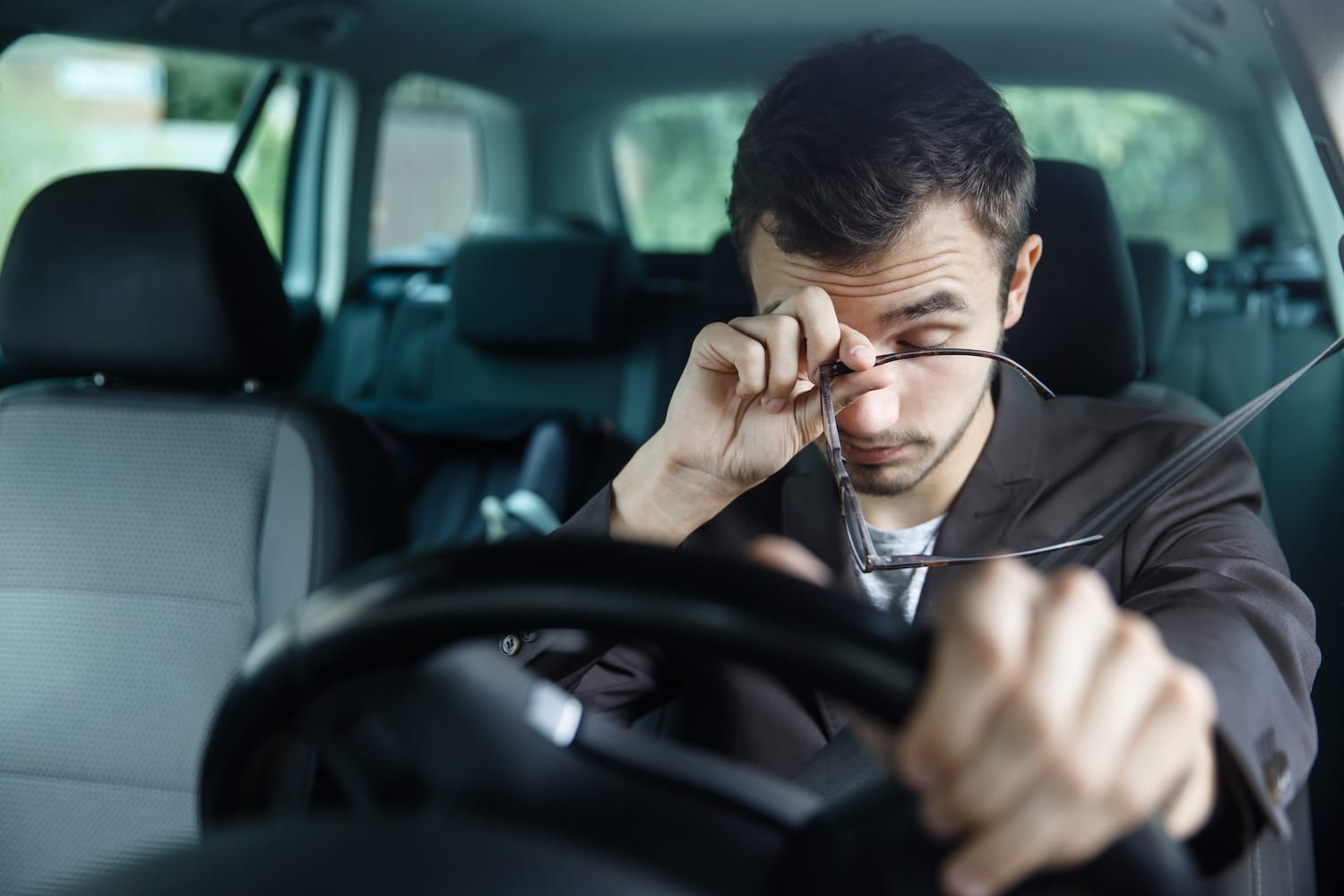When you buy through our links, we may earn a commission. Products or services may be offered by an affiliated entity. Learn more.
Narcolepsy: Causes, Symptoms, & Treatments
- Narcolepsy affects the brain’s ability to regulate sleep-wake cycles and causes persistent daytime sleepiness.
- Additional symptoms include disrupted sleep, sleep paralysis, and sleep-related hallucinations.
- Treatment for narcolepsy focuses on managing symptoms and reducing accident risk.
Narcolepsy is a sleep disorder that is often misunderstood. It is characterized by severe and persistent drowsiness that can cause impairments in school, work, and social settings as well as heighten the risk of serious accidents and injuries.
Although rare in comparison to many other sleep disorders, narcolepsy affects hundreds of thousands of Americans, including both children and adults.
Understanding the types of narcolepsy and their symptoms, causes, diagnosis, and treatment can empower people to manage it more effectively.
What Is Narcolepsy?
Narcolepsy is a disorder that disrupts sleep-wake processes. This disruption can cause excessive sleepiness, the primary symptom of narcolepsy, and make it hard for people with narcolepsy to stay awake for long periods of time.
Normal sleep unfolds through a series of stages, with rapid eye movement (REM) sleep occurring in the final stage, usually an hour or more after falling asleep. In narcolepsy, changes in the brain disrupt how sleep works. As a result, REM sleep is irregular and often begins within minutes after falling asleep, which is much earlier than normal. The inability to properly regulate the sleep cycle can lead to serious problems during the day.
According to the International Classification of Sleep Disorders, Third Edition (ICSD-3), there are two types of narcolepsy: narcolepsy type 1 (NT1) and type 2 (NT2).
Narcolepsy Type 1
NT1 is associated with the symptom of cataplexy, which is the sudden loss of muscle tone. However, not everyone who is diagnosed with NT1 experience episodes of cataplexy. NT1 can also be diagnosed when a person has low levels of hypocretin-1, a chemical in the body that helps control wakefulness.
Even when not present at diagnosis, cataplexy eventually occurs in a significant number of people with low levels of hypocretin-1.
Narcolepsy Type 2
People with NT2 have many similar symptoms as people with NT1, but they do not have cataplexy or low levels of hypocretin-1. Other sleep disorders also have similar symptoms to those found in NT2, which can make it hard to diagnose.
If a person with NT2 later develops cataplexy or low hypocretin-1 levels, their diagnosis can be reclassified as NT1.
How Common Is Narcolepsy?
Narcolepsy is relatively rare. NT1 affects between 20 and 67 people per 100,000 in the United States. According to a population based study in Olmstead county Minnesota, NT1 is two to three times more common than NT2, which is estimated to affect between 20 to 67 people per 100,000.
Calculating the prevalence of narcolepsy is challenging because of underdiagnosis and delays in diagnosis. Many people are not diagnosed with narcolepsy until years after their first symptoms . As a result, some estimates place the prevalence of narcolepsy as high as 180 per 100,000.
Narcolepsy occurs roughly equally in men and women and can affect both children and adults. It can occur at any age, but onset has been found to peak at around age 15 and again around age 35.
Narcolepsy Symptoms
The symptoms of narcolepsy can have notable effects during both daytime and night time.
Are Narcolepsy Symptoms Different In Children?
In children, EDS is more likely to appear as restlessness or irritability, which may be interpreted as a behavior problem. At night, children with narcolepsy may sleep longer and have more active body movements during sleep .
Cataplexy is often more subtle in children, although it occurs in up to 80% of cases . It commonly involves the face rather than the body and may be perceived as a facial tic. Over time, cataplexy symptoms in children evolve to their more traditional form.
What Are the Effects of Narcolepsy?
People with narcolepsy are at higher risk of other health conditions including cardiovascular problems like high blood pressure, and psychiatric issues like depression, anxiety, and attention-deficit/hyperactivity disorder (ADHD).
Accidents are a pressing concern as drowsiness, sleep attacks, and cataplexy can be life-threatening when driving or wherever safety is critical. It is estimated that people with narcolepsy are three to four times more likely to be involved in a car accident.
Narcolepsy can also interfere with school and work. Sleepiness and pauses in attention can harm performance and may be interpreted as behavioral problems, especially in children. Many people with narcolepsy feel stigma related to the condition that can lead to social withdrawal. Without proper support, this may contribute to mental health disorders and negatively affect school, work, and relationships.
What Causes Narcolepsy?
Research has started to reveal details about the underlying nature of narcolepsy. But even with growing knowledge, the exact causes and risk factors for each type are not fully understood.
NT1
Narcolepsy type 1 is identified by the loss of neurons in the brain that are responsible for making hypocretin, also known as orexin, a chemical that helps regulate wakefulness and sleep. People with NT1 have a loss of 90% or more of the normal amount of hypocretin-making neurons.
A genetically susceptible individual may experience damage to these neurons in an autoimmune fashion after an environmental trigger. Based on this data, one theory about NT1 is that an external factor triggers the immune system to attack the brain’s neurons that make hypocretin. However, this autoimmune response inconsistently occurs and therefore is not the only cause.
Researchers have found that as many as 98% of people with NT1 carry a gene variation known as DQB1*0602 . This gene variation could cause a genetic susceptibility to NT1, but it is not yet definitively proven .
Even though researchers know more than ever about NT1, most individual cases still occur with no clear, direct cause. People with a family history of NT1 have about a 1-2% chance of developing the condition. In rare cases, NT1 occurs because of another medical condition that causes damage to the parts of the brain containing hypocretin-producing neurons. This may be known as secondary narcolepsy, and it can occur from brain trauma or an infection in the central nervous system.
NT2
Little is known about the biology of or risk factors for NT2. Some experts believe that NT2 is simply a less pronounced loss of hypocretin-producing neurons. Others think NT2 may primarily be a precursor to NT1, but cataplexy has only been observed to develop in about 10% of cases of people initially diagnosed with NT2.
In some instances, NT2 has been reported following a viral infection, but most cases do not have an established cause. As with NT1, NT2 can arise because of other medical conditions such as head trauma, multiple sclerosis, and other diseases affecting the brain.
Narcolepsy Diagnosis
Diagnosis of narcolepsy requires careful analysis by a specialist. Because it is rare and symptoms may be mistakenly attributed to other causes, narcolepsy can go undiagnosed for many years.
The diagnostic process starts with a review of symptoms and medical history. This step helps the doctor understand the patient’s sleep habits and the nature of their symptoms. In many cases, family members are involved in order to provide more context about a person’s symptoms.
Polysomnography (PSG), a detailed test in which sensors monitor brain and body activity overnight in a specialized clinic, may be necessary to evaluate a person’s sleep architecture. The Multiple Sleep Latency Test (MSLT) may also be used to objectively assess sleepiness and how quickly REM sleep begins. During the MSLT, a subject will try to fall asleep at five different intervals while connected to sensors used in the PSG.
A lumbar puncture procedure may be done to remove cerebrospinal fluid (CSF) and assess its level of hypocretin. Low levels of hypocretin are indicative of NT1 and help distinguish it from NT2.
Narcolepsy Treatments
There is no cure for narcolepsy type 1 or type 2. The goals of treatment for narcolepsy are improving symptoms, reducing risks, and enhancing quality of life.
For many people, narcolepsy remains generally stable over time. In some cases, certain symptoms may improve over time, and rarely, remission of symptoms may happen spontaneously. So far, experts do not know why the disease unfolds differently in different people.
A combination of medical and behavioral approaches can significantly decrease symptoms, although some level of EDS normally persists despite treatment. All therapies should be carried out under the guidance of a doctor who can best tailor a treatment plan to a person’s specific situation.

Still have questions? Ask our community!
Join our Sleep Care Community — a trusted hub of sleep health professionals, product specialists, and people just like you. Whether you need expert sleep advice for your insomnia or you’re searching for the perfect mattress, we’ve got you covered. Get personalized guidance from the experts who know sleep best.
References
12 Sources
-
American Academy of Sleep Medicine. (2014). International Classification of Sleep Disorders — Third Edition (ICSD-3) (Online).
https://aasm.org/ -
Pérez-Carbonell, L., & Leschziner, G. (2018). Clinical update on central hypersomnias. Journal of Thoracic Disease, 10(S1), S112–S123.
https://pubmed.ncbi.nlm.nih.gov/29445535/ -
Silber, M. H., Krahn, L. E., Olson, E. J., & Pankratz, V. S. (2002). The epidemiology of narcolepsy in Olmsted County, Minnesota: A population-based study. Sleep, 25(2), 197–202
https://pubmed.ncbi.nlm.nih.gov/11902429/ -
Thorpy, M. J., & Krieger, A. C. (2014). Delayed diagnosis of narcolepsy: Characterization and impact. Sleep Medicine, 15(5), 502–507.
https://pubmed.ncbi.nlm.nih.gov/24780133/ -
Pizza, F., Franceschini, C., Peltola, H., Vandi, S., Finotti, E., Ingravallo, F., Nobili, L., Bruni, O., Lin, L., Edwards, M. J., Partinen, M., Dauvilliers, Y., Mignot, E., Bhatia, K. P., & Plazzi, G. (2013). Clinical and polysomnographic course of childhood narcolepsy with cataplexy. Brain: A Journal of Neurology, 136(Pt 12), 3787–3795.
https://pubmed.ncbi.nlm.nih.gov/24142146/ -
Antelmi, E., Pizza, F., Vandi, S., Neccia, G., Ferri, R., Bruni, O., Filardi, M., Cantalupo, G., Liguori, R., & Plazzi, G. (2017). The spectrum of REM sleep-related episodes in children with type 1 narcolepsy. Brain: A Journal of Neurology, 140(6), 1669–1679.
https://pubmed.ncbi.nlm.nih.gov/28472332/ -
Challamel, M. J., Mazzola, M. E., Nevsimalova, S., Cannard, C., Louis, J., & Revol, M. (1994). Narcolepsy in children. Sleep, 17(8 Suppl), S17-20.
https://pubmed.ncbi.nlm.nih.gov/7701194/ -
McCall, C. A., & Watson, N. F. (2020). Therapeutic strategies for mitigating driving risk in patients with narcolepsy. Therapeutics and Clinical Risk Management, 16, 1099–1108.
https://pubmed.ncbi.nlm.nih.gov/33209031/ -
Abad, V. C., & Guilleminault, C. (2017). New developments in the management of narcolepsy. Nature and Science of Sleep, 9, 39–57.
https://pubmed.ncbi.nlm.nih.gov/28424564/ -
Ollila, H. M. (2020). Narcolepsy type 1: What have we learned from genetics? Sleep, 43(11), zsaa099.
https://pubmed.ncbi.nlm.nih.gov/32442260/ -
Tafti, M., Hor, H., Dauvilliers, Y., Lammers, G. J., Overeem, S., Mayer, G., Javidi, S., Iranzo, A., Santamaria, J., Peraita-Adrados, R., Vicario, J. L., Arnulf, I., Plazzi, G., Bayard, S., Poli, F., Pizza, F., Geisler, P., Wierzbicka, A., Bassetti, C. L., … Kutalik, Z. (2014). DQB1 locus alone explains most of the risk and protection in narcolepsy with cataplexy in Europe. Sleep, 37(1), 19–25.
https://pubmed.ncbi.nlm.nih.gov/24381371/ -
Fronczek, R., Arnulf, I., Baumann, C. R., Maski, K., Pizza, F., & Trotti, L. M. (2020). To split or to lump? Classifying the central disorders of hypersomnolence. Sleep, 43(8).
https://pubmed.ncbi.nlm.nih.gov/32193539/







